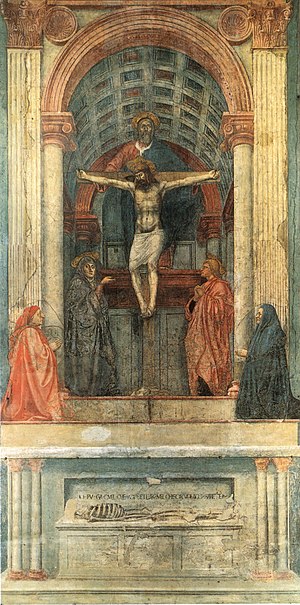Holy Trinity (Masaccio)
| The Holy Trinity | |
|---|---|
 |
|
| Artist | Masaccio |
| Year | 1425 |
| Type | fresco |
| Dimensions | 667 cm × 317 cm (263 in × 125 in) |
| Location | Santa Maria Novella, Florence |
 |
|
|
|
|
|
|
The Holy Trinity, with the Virgin and Saint John and donors (Italian: Santa Trinità ) is a fresco by the Early Italian Renaissance painter Masaccio. It is located in the Dominican church of Santa Maria Novella, in Florence.
The Trinity is thought to have been created by Masaccio sometime between 1425-1427. He died in late 1428 at the age of 26, or having just turned 27, leaving behind a relatively small body of work. This painting was one of his last major commissions, and is considered to be one of his masterpieces.
The fresco is located along the middle of the basilica's left aisle. Although the configuration of this space has changed since the artwork was created, there are clear indications that the fresco was aligned very precisely in relationship with the sight-lines and perspective arrangement of the room at the time; particularly a former entrance-way facing the painting; in order to enhance the tromp l'oeil effect. There was also an altar, mounted as a shelf-ledge between the upper and lower sections of the fresco, further emphasizing the "reality" of the artiface.
Not much is known about the details of the commission; no contemporaneous documents naming the altar-piece's patron(s) have been found. The two donor portraits included in the fresco, one figure kneeling on either side of the archway, have not been positively identified. The persons depicted are almost certainly contemporary Florentines; either the persons who funded the work, or relatives or close associates. According to the established conventions of such depictions, it is generally, but not universally, assumed that they were probably still alive at the time of the artwork's commissioning. Presumably, the representations in the painting serve as relatively accurate likenesses of their actual appearance at the time when their portraits were created.
The leading theories as to their identity favour two local families; either the Lenzi or, for at least one of the figures, a member of the Berti, who were a working-class family from the Santa Maria Novella quarter of Florence. According to recently discovered (as of 2012) records of the Berti family, they owned a tomb at the foot of the fresco, and it has been suggested that they might have had a particular "devotional loyalty" to veneration of the Holy Trinity. Other sources mention a Lenzi tomb near the altar, with the inscription "Domenico di Lenzo, et Suorum 1426", as well as other Lenzi decorations in the chapel at that time, and assume the donor portraits to be posthumous images of Domenico (and his spouse?); based on the full-profile pose used for the figures. In the Florentine dating system of that time, the new year began on March 25; and factoring in the conversion from Julian to Gregorian calendars Domenico's death, as recorded, would have been on 19 January 1427.
...
Wikipedia
